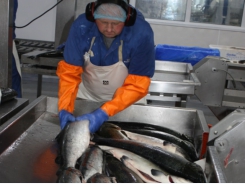Aquatic animal disease and human health

Introduction
There are some fish diseases and infections that can be transmitted from fish, and the water in which they are cultured, to humans. Although the infection of humans with fish pathogens is a relatively unusual event, it is a health risk that needs to be recognised by fish farmers and other people who handle and/or consume farmed seafood.
The incidence of transmission of disease from fish to humans is dependant upon several factors including the type of organism (viral, parasitic or bacterial), the susceptibility of the host (immuno-compromised individuals, presence of open wounds) and environmental factors (quality of the water, depth of penetration of fish spines).
Most disease causing agents which can transmit from fish to humans are bacterial and their clinical effects and treatments are listed in Table 1.
Optimum farm design, appropriate husbandry and handling, water quality management and regular fish health monitoring will reduce the risk of disease transfer from fish and their environs to workers in the aquaculture industry.
Bacterial diseases
Table 1. Some common bacteria and their clinical effects following infection in humans. Some species have been recorded in Australian fishes. Clostridium botulinum is also found occasionally in the intestinal tract of fish.
| Bacteria | Clinical Effects | Treatment |
| Aeromonas hydrophila | Serious infection uncommon Usually in immuno-compromised individuals; cellulitis, muscle necrosis or septicaemia | Antibiotics Ampicillin resistant |
| Edwardsiella tarda | Soft tissue infections; arthritis; septicaemia; gastroenteritis; meningitis; osteomyelitis | Antibiotics |
| Erysipelothrix rhusiopathiae | Skin infection (on hands), septicaemia, endocarditis (rare); lymphangitis | Antibiotics; most strains resistant to Vancomycin |
| Streptococcus iniae | Suppurating ulcers; cellulitis; Lymphadenitis; septacaemia; Endocarditis and arthritis | Antibiotics |
| Vibrio spp. | Lesions; gastroenteritis; septicaemia | Antibiotics |
| Mycobacterium marinum | Skin lesions (usually hands); ulceration and inflammation of joints | Antibiotics |
| Salmonellosis | Septicaemia; abdominal pain; diarrhoea; nausea; vomiting | Antibiotics |
Non-bacterial fish disease pathogens capable of infecting humans
Non-bacterial disease-causing agents include:
⦁ Parasites and harmful algae
⦁ Viruses
⦁ Parasitic diseases and harmful algae
Several parasites can infect humans as non-traditional hosts. They enter humans by ingestion of raw or undercooked infected fish. Trematodes and nematodes are known to cause infection in humans. Harmful algae (dinoflagellates and diatoms) may also accumulate in shellfish and can cause illness in humans. Clinical signs can include muscular aches, gastrointestinal and neurological disorders.
Viral diseases
Shellfish, such as oysters, mussels and clams can bio-accumulate viral pathogens from polluted waters. The consumption of contaminated shellfish can cause gastroenteritis, respiratory illness, fever and hepatitis. Commercial shellfish are grown under a strict food safety program administered by the NSW Food Authority.
Prevention and control
Fish should be anaesthetised during handling to avoid injury to fish and fish handlers.
Gloves should be worn at all times when handling fish.
Minor wounds should be thoroughly washed with clean water and antiseptic applied.
More serious injuries and illness should be treated by a medical practitioner.
Doctors should be informed if "fish handling" is involved.
Workers having an underlying disease or compromised immune system (diabetes, impaired liver function, cancer or HIV) are more susceptible, and should avoid handling fish.
Workers having open wounds, cuts or abrasions should not come into contact with fish or fish rearing waters.
Codes of hygienic practice and good aquaculture practices are essential to lower the risk to employees.
Educating workers about the prevalence of these risks will go a long way to preventing these diseases.
Glossary
Cellulitis– inflammation of cellular tissue.
Endocarditis– inflammation of the membranes which line the heart and heart valves.
Lymphadenitis– chronic swelling of lymph nodes
Meningitis– inflammation of the brain and spinal chord membranes.
Osteomyelitis– inflammation of the bone
Septicaemia– bacterial infection of the blood
Suppurating- discharging pus from a wound.
Related news
Tools

Phối trộn thức ăn chăn nuôi

Pha dung dịch thủy canh

Định mức cho tôm ăn

Phối trộn phân bón NPK

Xác định tỷ lệ tôm sống

Chuyển đổi đơn vị phân bón

Xác định công suất sục khí

Chuyển đổi đơn vị tôm

Tính diện tích nhà kính

Tính thể tích ao



 Novel sea lice treatment gains medical approval
Novel sea lice treatment gains medical approval  Maintaining water quality in RAS: the essentials
Maintaining water quality in RAS: the essentials